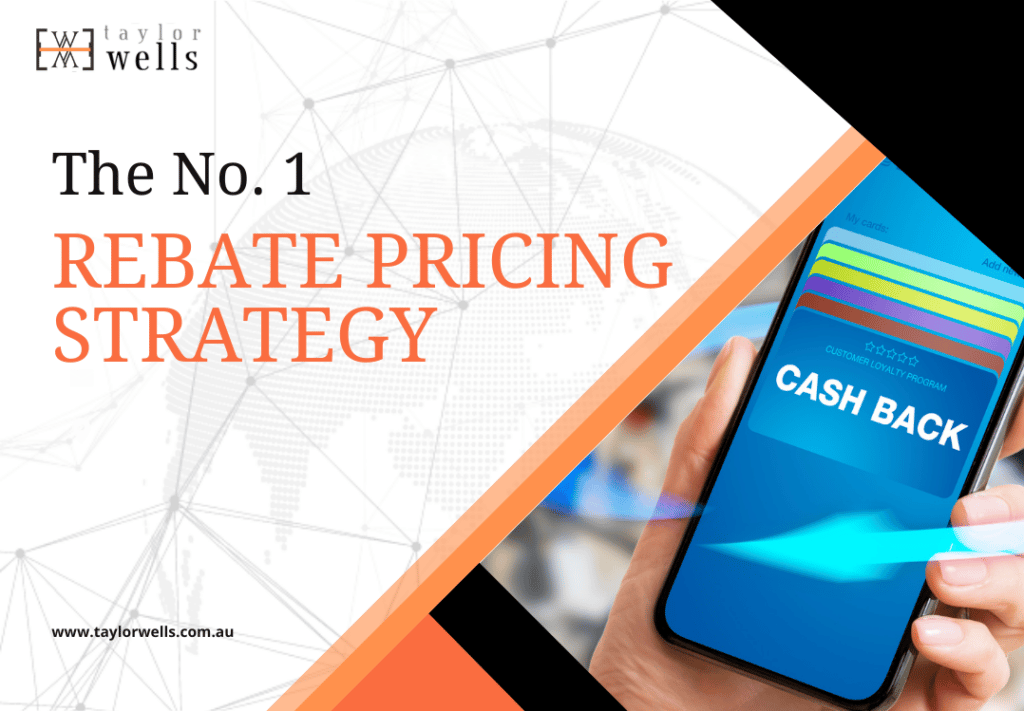
The No.1 Rebate Pricing Strategy To Maximise Margins 🎗️
The capability to maximise margins while offering financial incentives is an important proposition for customers. Especially new customers that are cautious about the purchasing process and or existing customers experiencing margin pressure as a result of the recent crisis. This is where the right B2B rebate pricing strategy can be a powerful tool and option for sellers. As rebates can be a great way to close deals, secure cash flow and maximise margins across the product portfolio.
>Download Now: Free PDF The No. 1 Rebate Pricing Strategy
The problem is, though, B2B rebate pricing strategy, design and management still have a lot of grey areas. It can be difficult to construct a rebate pricing strategy that truly maximises margins for the business while offering value to different types of customers. We ask, then: Is there a rebate pricing strategy that can help managers to drive more revenue and margin and more customer commitment and loyalty?
So, in this article, we will discuss and evaluate a variety of rebate pricing strategy examples in more detail. We argue that if you are using rebates to reward incremental volume; review the quantity breaks in your pricing structure, avoid haggling with customers on a line item level, and start applying an ‘active’ rebate scheme to regain control of the relationship with customers.
At Taylor Wells Advisory, we believe that every element in the price waterfall of a business should be there for a specific purpose as it helps companies determine its profitability. This is especially true with a good rebate pricing strategy.
At the end of this article, you will learn how to employ a set of rules for your rebates to ensure you make (rather than lose) margin on each sale. Including how to evaluate and structure rebates for different purposes, and what processes you need for applying rebates to different customer groups.

What is a rebate?
Simply put, rebates are cashback or cash refunds that customers receive from sellers for committing to spend more with them. In other words, they are a form of price incentive or reward a seller offers a customer for committing to buying more volume or a mix of products or services. The seller may provide the customers with rebates in various forms, such as: mail-in rebates, flat-rate rebates, or conditional rebates (discussed in detail below). The overall intention of using rebates, regardless of the form it takes, however, is to incentivise or influence customers to commit to buying more of what the business is selling. Many businesses also see rebates as a good way to lock customers to higher-value purchases over a longer period of time.
Different Types of Rebates Pricing Strategy
As mentioned above, there are various forms of rebate pricing strategy. Below listed are just a few of the most popular rebate schemes that businesses use to influence their customers to buy more or differently:
Volume Rebates: The simplest among rebates designed to limit customer gaming and over-promising. Tiered-pricing is used and varies with the actual volume of the order placed instead of quoting a price based on a customer’s promised order volume. Usually, paid quarterly.
Growth rebates: These are a variation on volume rebates and are outlined to improve the volume growth of a particular product group. Typically paid on a targeted percentage in volume.
Mix rebates: This rebate is used to motivate a distributor or B2C business to sell a bigger volume of products with a higher profit margin. Rebates should hardly ever be a constant percentage, for instance, 3% on all revenue as it will be misinterpreted as a discount.
Retention rebates: These rebates are used to reward customer loyalty or continued business. They are accrued over time and paid at the end of the year. The rebate can be any form, it can be growth, volume, or mix. Retention rebates are an incentive for B2B customers to purchase consistently over a specified period.
Why use rebates?
The benefits of rebates for customers are significant. Customers like rebates because they receive monetary reimbursements for committing to significant purchases – and everyone likes to feel they are getting value for money. Also, the customer can go back and show their business they have made a cost-saving through the rebate scheme even though the upfront spend is higher.
In effect, then, customers can get more value for their money through a rebate scheme as they are not paying the full list price for goods purchases. And, sellers can push more volume, lock-in cash and at hopefully make a margin using rebates.
Advantages and disadvantages of rebates pricing strategy
Advantages
Creating a rebate offer, then, can often create a loyal customer base in many ways (listed below):
1. Customers are motivated to get value for money when they make a purchase. Many customers, for example, prefer to make a purchase that also feels financially responsible -i.e., they get a kick out of getting money back or cost savings.
2. Customers tend to remember businesses that personalised their rebates. Studies show, for example, that customers are much more likely to be loyal to existing suppliers when they felt like the rebate and incentive structure helped them to lower their costs of doing business.
3. Rebates help to influence future customer behaviour. Studies show, for example, that customers tend to check in first with existing suppliers that offered them rebates before consulting other suppliers.
4. Rebate programmes with customer’s demographic profiles can also help to determine customers’ buying patterns. They can also be useful for future promotions, deal and rebate structures.
Rebate programs, then, do appeal to budget-conscious customers, however, they can also help to remind high-value customers to be loyal to existing suppliers when they need to buy similar products or services in the future.
Disadvantages
1. Effort and complicated procedures
Complex rebate procedures can reduce a rebate program’s success. For instance, a customer may not go through all required processes such as purchase verification and not commit to agreed volumes. This can reduce the efficacy of a current rebate and will jeopardise future rebate programs. Not only that, but the profitability of the account as well.
2. Execution and program management problems
Managing a rebate program improperly can damage both a company’s reputation including its brand. For example, assigning too many staff to manage rebate tasks can impact internal operations and overall productivity. Conversely, assigning too few or inexperienced staff can cause delays in processing and increase customer complaints. Executing and supervising a rebate program in-house incorrectly, then can result in a substantial time cost for a company.
Design and structural problems
Rebates need to be enticing to be effective. Unfortunately, more often than not, rebates are poorly conceived and structured and largely un-managed. At Taylor Wells, we believe the problem with rebates comes down to this:
1) miscalculated quantity breaks
2) considering quantity in absolute terms rather than in relation to changes in price, cost, mix; very seldom measured against margin changes
3) un-managed, poorly structured, and passive rebates; customer agree to buy certain volumes of product, but often don’t stick to the agreed amount stipulated in the agreement
4) the seller leaks margin across their customer base as their rebate channel strategy has worked against them
In effect, then, even though rebates present sellers with a good opportunity to generate more value from their product portfolio, they end up doing completely the opposite. What’s more, commonly, businesses losing money through a poorly managed passive rebate scheme also offer excessive discounts. Oftentimes, without even realising it. The customer is happy, but the business loses out big time.
Discussion: Are rebates effective?
Although good in theory, many rebate pricing strategy scenarios do not always work out well for the seller. Selling organisation frequently lament using rebates and complain they are a money pit. As noted above, this is largely because rebates are either not structured properly, poorly managed and or the customer commits to spending a higher amount in the agreement but does not commit in reality (i.e., buys under the committed amount or does not buy the mix of products they agreed). Often – especially in this last scenario – the seller does not call the customer on this breach in the contract and the price agreement rolls on even though the customer is loosely or ‘passively’ agreeing to contractual terms.
In fact, only about 20% of businesses use rebates effectively. This indicates that there are only a small number of business that have the required know-how to calibrate their rebate schemes with their discounting practices to ensure they are not giving away value and margin for nothing. Interestingly, this small percentage of businesses that do manage rebates well also tend to rely on value-based rebate pricing principles.
Examples of a well-managed rebate pricing strategy using value-based thinking often include the following behaviours and pricing mechanisms:
- There’s a pricing team dedicated to pricing and rebates.
- Price incentives are often complemented by a well-constructed and data driven customer loyalty programme.
- The pricing team ‘actively’ manages rebate programmes to ensure compliance with agreed terms. This means, deploy a full-time pricing team to create the right incentives to influence the right customer buying behaviours.
- There’s a dashboard to monitor product margins for each deal or bundle.
- The team has calibrated rebates and discounts to an agreed percentage to ensure that product and deal profitability never goes below costs.
The pricing team, then, is a key element in good rebate management. They will utilise active rebate schemes to prevent excessive discounting on a line item level while securing volumes. In many respects, a good rebate offers customers real value without giving it away for free or cannibalising product offering.
Implications
Use rebates to avoid price actions that create downward price pressure. If a customer’s organisation has trouble with the administration, management, or analysis of rebates, do not offer them ‘tactical’ rebates. It’s more hassle than it’s worth and will increase your costs of doing business with this customer.
Many companies use overly complex rebate standards to make more revenue and margin. Oftentimes the desired customer behaviours you want to maximise margin doesn’t eventuate as an outcome of these increasingly complex rebates.
Every organisation should carefully evaluate rebate performance. If the rebate system is achieving its objective to attract the customers and bring in more profitable revenue growth this is good news. If it’s not, discontinue the rebate system.
Tips: How to increase sales using rebates pricing strategy
To attract business executives with your products, a rebate should be appealing so they’ll choose your brand over your competition
Below listed are some of the ways rebates can help increase your sales.
-
Include an expiration date on rebates.
This keeps business matters organised. Deadlines also help to remind the customer of the rules of the program. In addition, it will help ensure you don’t offer to pay rebates to customers that fail to send in their forms on time.
-
Refine rebate programs that instil customer loyalty.
Rebate programs provide a cash incentive to customers without making expectations of a low price for your products.
-
Call out bad behaviours.
Calling out bad behaviours will save your company money on paying for unqualified or fraudulent rebates. Why offer a rebate to customers that are not paying you. Many sellers don’t call out bad behaviours because they fear they’ll lose their customers’ business entirely. However, in many instances, it comes down to oversight. Like for instance, the customer simply forgot i.e., they were not monitoring their spend either.
-
Implement your rebates for a long enough duration.
It will give you enough time to receive adequate feedback from your customers on key marketing strategies. In addition, when you offer rebates and incentives, it might make leaders question the return on investments.
〉〉〉 Get Your FREE Pricing Audit 〉〉〉
Conclusion
When developing the right rebate pricing strategy and tactics to maximise margins, there is no one cookie-cutter answer or approach. This is because the right rebate pricing strategy should totally depend on the nature of the business, pricing structure, product portfolio, deal mechanics and the needs of the customers (e.g., their spend, where they fit in your segmentation, their volume commitments, their operations requirement, their supply chain needs, how loyal they are and have been to you).
Two very important customer-oriented pricing goals to consider, therefore when creating rebates are. How to increase customer loyalty while at the same time maximising profit margins. What does a good pricing agreement look like and will your customer agree? Do you really have all the terms and conditions, prices and incentives to generate value for the business and the customer?
Attaining both of these pricing goals is the basis of an effective rebate pricing strategy. Saying this, however, for many reasons (outlined above) executing a profitable rebate pricing strategy has proven difficult to implement with customers for many businesses. With many rebate pricing strategies turning out to be a money pit; often rewarding bad customer behaviours.
Click here to access your free pdf guide on driving pricing strategy in your business.
For a comprehensive view on building a great pricing team to prevent loss in revenue,
Download a complimentary whitepaper on How to Build Hiring Capability To Get The Best Pricing Team.
Are you a business in need of help to align your pricing strategy, people and operations to deliver an immediate impact on profit?
If so, please call (+61) 2 9000 1115.
You can also email us at team@taylorwells.com.au if you have any further questions.
Make your pricing world-class!
Related Posts
Leave a Reply Cancel reply
Categories
- marketing strategy (26)
- Organisational Design (14)
- Podcast (114)
- Pricing Capability (87)
- Pricing Career Advice (10)
- Pricing Recruitment (19)
- Pricing Strategy (291)
- Pricing Team Skills (13)
- Pricing Teams & Culture (25)
- Pricing Transformation (47)
- Revenue Model (25)
- Sales Effectiveness (27)
- Talent Management (7)
- Technical Pricing Skills (35)






